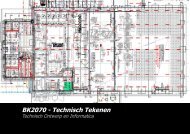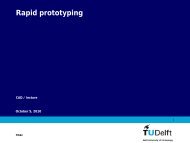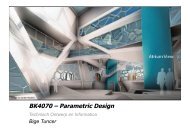for new territories only locally and with ad hoc solutions. It became clear that the problem shouldbe considered from a wider po<strong>in</strong>t of view hav<strong>in</strong>g <strong>in</strong> m<strong>in</strong>d the future development of a larger area.Randstad is an area that <strong>in</strong>cludes four major cities, Amsterdam, Den Haag, Rotterdam andUtrecht. These cities were supposed to be a part of one larger area, <strong>in</strong> which each one wouldma<strong>in</strong>ta<strong>in</strong> their own identity. A renewal of these cities was <strong>in</strong>evitable and some alternativesolutions were needed to solve problems with <strong>in</strong>creas<strong>in</strong>g population and new functions thatneeded to be accommodated as well. This renewal came also as a wish to ma<strong>in</strong>ta<strong>in</strong> and improvethe quality of life <strong>in</strong> urban areas. In the past, some of the canals were filled and replaced bystreets <strong>in</strong> order to expand a city’s traffic. Such <strong>in</strong>terventions totally changed the atmosphere ofstreets, by submitt<strong>in</strong>g space to cars. At that time, it seemed to solve some temporary problems but<strong>in</strong> the end, such actions deteriorated the quality of life <strong>in</strong> cities. In search for new territories, theidea of utiliz<strong>in</strong>g underground space slowly came to the surface. It was seen as one possibility tosolve not only the traffic problems but also to accommodate other public functions vital for aserviceable, modern city. In such way, historical city centers can be preserved and the pressurefrom the surface relieved. At this po<strong>in</strong>t, the M<strong>in</strong>istry of Hous<strong>in</strong>g, Spatial Plann<strong>in</strong>g andEnvironment (M<strong>in</strong>isterie van Volkshuisvest<strong>in</strong>g, Ruimtelijke Orden<strong>in</strong>g en Milieubeheer - VROM)made a decision to stimulate research <strong>in</strong> the area of build<strong>in</strong>g underground. In first <strong>in</strong>stance, therewas a need to get a grip on techniques and construction methods, but also on design aspects andthe quality of underground spaces. For that reason, a Center for Build<strong>in</strong>g <strong>Underground</strong> (CentrumOndergronds Bouwen - COB) was established <strong>in</strong> 1994 as a central body that would direct andcluster the research <strong>in</strong> that area. With<strong>in</strong> COB, six clusters were established (COB, 2000):•= Spatial design•= Plann<strong>in</strong>g and governmental <strong>in</strong>struments•= <strong>Perception</strong> and safety•= Natural and environmental aspects•= Technology•= Economy and processesVarious research projects are still be<strong>in</strong>g <strong>in</strong>itiated with<strong>in</strong> these clusters. Another COB task was to<strong>in</strong>itiate education and research program at <strong>Delft</strong> University of Technology. At the faculty of CivilEng<strong>in</strong>eer<strong>in</strong>g <strong>in</strong> <strong>Delft</strong>, a chair '<strong>Underground</strong> Build<strong>in</strong>g' was established <strong>in</strong> 1995 together with the<strong>in</strong>terfaculty workgroup 'Usage of <strong>Underground</strong> Space' (Gebruik Ondergrondse Ruimte - GOR).In a document "A New Map Deepen" (COB, 1997) three ma<strong>in</strong> advantages for build<strong>in</strong>gunderground <strong>in</strong> urban areas were given:•= More efficient use of space - by plac<strong>in</strong>g some functions underground, additional spacebecomes available above ground for other functions. The ma<strong>in</strong> pr<strong>in</strong>ciple here is the multipleusage of space where functions are 'piled' on top of each other.•= Strengthen<strong>in</strong>g spatial functionality - very often a traffic <strong>in</strong>frastructure is a cause of unnaturalsegregation of urban areas and is seen as physical, visual and aesthetic barriers. Anotherimportant issue is preservation of historical heritage.•= Improv<strong>in</strong>g quality of the surround<strong>in</strong>g - by plac<strong>in</strong>g some parts of the <strong>in</strong>frastructureunderground, environmental quality <strong>in</strong> the surround<strong>in</strong>g area would be improved, by reduc<strong>in</strong>gnoise, improv<strong>in</strong>g air quality and connect<strong>in</strong>g two city parts. This was the case with theunderground tra<strong>in</strong> station at Rijswijk (see Chapter 5, Section 5.2.1.).- 10 -
In short, utiliz<strong>in</strong>g underground space would create a potential to improve our urban environmentby reliev<strong>in</strong>g pressure from the surface, develop<strong>in</strong>g better public transport networks betweencities, reduc<strong>in</strong>g noise and improv<strong>in</strong>g air quality, and leav<strong>in</strong>g more green areas <strong>in</strong> city center<strong>in</strong>tact. Follow<strong>in</strong>g these developments, <strong>in</strong> 1999 the Expertise Network Multiple Space Usage(Expertisenetwerk Meervoudig Ruimtegebruik - EMR) was established. The ma<strong>in</strong> aspectsunderstood under a term multiple space usage are (Lagendijk and Wisserhof, 1999):1. Intensification of space usage (improv<strong>in</strong>g the efficiency of space usage)2. Intertw<strong>in</strong><strong>in</strong>g space usage (usage of the same space by several functions)3. Third dimension of space usage (usage of underground as well as above ground space)4. Fourth dimension of space usage (subsequent usage of the same space by several functions)In short, multiple space usage can be def<strong>in</strong>ed as "accomplish<strong>in</strong>g more functions <strong>in</strong> a given spaceand given time" (Priemus, et. al., 2000). This strengthens the position of underground spacewith<strong>in</strong> a far larger scope. From all of the above, it is evident that the last decade represents theflourish<strong>in</strong>g years for underground space research and development <strong>in</strong> the Netherlands whichcont<strong>in</strong>ues to the present time. In the document 'Spatial Exploration 2001' (RuimtelijkeVerkenn<strong>in</strong>g 2000) the underground is recognized by policy makers as a promised land and a'f<strong>in</strong>al frontier' (VROM, 2000).In the Fifth Bill regard<strong>in</strong>g Spatial Plann<strong>in</strong>g (VROM, 2001; 5de Nota Ruimtelijke Orden<strong>in</strong>g), thegovernment set as a goal the development of six urban networks of similar size. These networksare urbanized areas that form a network comprised of larger and smaller compact cities, eachreta<strong>in</strong><strong>in</strong>g their own characteristics with<strong>in</strong> that network. This decision requires a different sort ofplann<strong>in</strong>g than was done up until now. One of these urban networks is the Randstad, which nowhas evolved to a type of Delta-metropolis and is characterized by the highest density. With itssize and population, Delta-metropolis can be compared to other large urban areas <strong>in</strong> Europe andthe rest of the world. The region between and around the cities of Amsterdam, Leiden, Den Haag,Rotterdam, Gouda, Utrecht, Amersfoort and Almere is referred to as the Delta-metropolis. TheDelta-metropolis is the most densely populated part of the Netherlands. It covers an area ofaround 60 x 80 km (4800 km 2 ) where altogether 5 million people live and work. It has a veryhigh population density of more than 1000 <strong>in</strong>habitants per km 2 . This is the ma<strong>in</strong> reason it isreferred to as a metropolis. It is also a region that lies <strong>in</strong> the delta of Rijn, Maas and Schelderivers. This expla<strong>in</strong>s the name delta. In the same Bill, the amount of functions expressed <strong>in</strong> m 2and required for future development were given as well (VROM, 2001). These requirementsclearly show that the pressure on the urban areas <strong>in</strong>creases and therefore the necessity toreconsider and restructure cities becomes greater. In this Bill, three ma<strong>in</strong> <strong>in</strong>tervention strategieswere proposed:- <strong>in</strong>tensification- comb<strong>in</strong>ation- transformationThese strategies should lead to more efficient space usage so that new/extra functions can be<strong>in</strong>corporated. In that respect, the multiple space usage, <strong>in</strong>clud<strong>in</strong>g build<strong>in</strong>g underground as animportant part of it, is <strong>in</strong>dicated by the policy makers as important options <strong>in</strong> future plann<strong>in</strong>g. Anexample of these three strategies is the Master Plan Rotterdam CS, where an exist<strong>in</strong>g <strong>in</strong>terchangestation is be<strong>in</strong>g developed <strong>in</strong>to a mobility hub with high concentration of recreational activities,bus<strong>in</strong>ess and apartments (Alsop Architects, 2001). The important station locations <strong>in</strong> Deltametropolisbut also <strong>in</strong> other areas are seen as generators of activities. It is an efficient way to- 11 -
- Page 5: ContentsChapter 1 Introduction 11.1
- Page 9 and 10: CHAPTER 1Introduction1.1. Backgroun
- Page 11 and 12: In the Netherlands, most publicly u
- Page 13 and 14: spaces. There are also other aspect
- Page 15 and 16: The information to be processed is
- Page 17: CHAPTER 2From spatial planing to pe
- Page 21 and 22: Up until now it has been shown that
- Page 23 and 24: the information but also the desire
- Page 25 and 26: Another important conclusion is rel
- Page 27 and 28: develop a generic method to model t
- Page 29 and 30: In order to define the working area
- Page 31 and 32: spatialenvironmenthuman beingmental
- Page 33 and 34: CHAPTER 3Identification of the mode
- Page 35 and 36: case of emergency. Interestingly, t
- Page 37 and 38: judgement and experience of space.
- Page 39 and 40: Figure 4: View over the platform. U
- Page 41 and 42: •= Layout including both spatial
- Page 43 and 44: comfort seems to fulfill a biologic
- Page 45 and 46: Spatial CharacteristicsSpatial char
- Page 47 and 48: material/coloroverviewconstructione
- Page 49 and 50: Another aspect is the transparency
- Page 51 and 52: there are three key issues that are
- Page 53 and 54: •= the questions were closed, whi
- Page 55 and 56: CHAPTER 4Theoretical background on
- Page 57 and 58: some way or other has "memory". Add
- Page 59 and 60: XoWEIGHTSArtificial NeuronX1X2 Wj2.
- Page 61 and 62: Xthe inputspace(domain)inputsoutput
- Page 63 and 64: the text. This implies that general
- Page 65 and 66: numerical values. A variable is cal
- Page 67 and 68: artificial neural networks versus f
- Page 69 and 70:
Figure 11: The inverse quadratic fu
- Page 71 and 72:
part of the data as receptive field
- Page 73 and 74:
The main feature of expert systems
- Page 75 and 76:
• Use logical (deductive) reasoni
- Page 77 and 78:
CHAPTER 5Experimental research: Cas
- Page 79 and 80:
Figure 2: The old and new situation
- Page 81 and 82:
Figure 8, 9: Entrance to platform (
- Page 83 and 84:
Beurs/Churchillplein station is sit
- Page 85 and 86:
Figure 22, 23: The main entrance to
- Page 87 and 88:
Table 2: Aspects related to comfort
- Page 89 and 90:
5.3.3. ResponseFrom 27 May until 30
- Page 91 and 92:
7060605050404030302020Percentage100
- Page 93 and 94:
5.4.5. Way of orientingIn Figures 4
- Page 95 and 96:
Table 7: Perception of comfort in t
- Page 97 and 98:
CHAPTER 6Experimental research by k
- Page 99 and 100:
of input information i.e., the case
- Page 101 and 102:
Figure 3: Training results for rang
- Page 103 and 104:
Experiment 2aThe first 28 parameter
- Page 105 and 106:
formed by this knowledge model. In
- Page 107 and 108:
Table 4: Hierarchical order of sens
- Page 109 and 110:
Table 8: Hierarchical order of sens
- Page 111 and 112:
information structured as a knowled
- Page 113 and 114:
elationship it is understood to be
- Page 115 and 116:
10.80.60.40.201 4 7 10 13 16 19 22
- Page 117 and 118:
wilhelmina11.624.164.3wilhelmina36.
- Page 119 and 120:
wilhelmina6.720.373rijswijkblaak22.
- Page 121 and 122:
This study considered both metro an
- Page 123 and 124:
Some specific conclusions can be ma
- Page 125 and 126:
wilhelminarijswijkblaakbeurs9.62.59
- Page 127 and 128:
CHAPTER 7Conclusions and recommenda
- Page 129 and 130:
Furthermore, this research is also
- Page 131 and 132:
Additional efforts to improve knowl
- Page 133 and 134:
integrated computational intelligen
- Page 135 and 136:
Appendix A: Questionnaire for Blaak
- Page 137 and 138:
DEEL 3:HET VINDEN VAN DE WEGVraag 1
- Page 139 and 140:
DEEL 8:VERLICHTINGVraag 26: In hoev
- Page 141 and 142:
Appendix B : Learning based data an
- Page 143 and 144:
For further explanation regarding s
- Page 145 and 146:
ReferencesAlsop Architects (2001).
- Page 147 and 148:
COB (2000). Jaarverslag 1999. Centr
- Page 149 and 150:
Leonard J.A., Kramer M.A., and Unga
- Page 151 and 152:
Van Wegen, H. B. R. and Van der Voo
- Page 153 and 154:
SummaryThe intensification, combina
- Page 155 and 156:
aspects, which is derivation of dep
- Page 157 and 158:
SamenvattingBelevingsaspecten van O
- Page 159 and 160:
krachtige combinatie te zijn voor h
- Page 161 and 162:
AcknowledgmentsAfter formal discuss
- Page 163 and 164:
About the authorSanja Durmisevic wa
- Page 165 and 166:
BibliographyJournal publicationsDur
- Page 167:
Ciftcioglu Ö., Durmisevic S. and S





